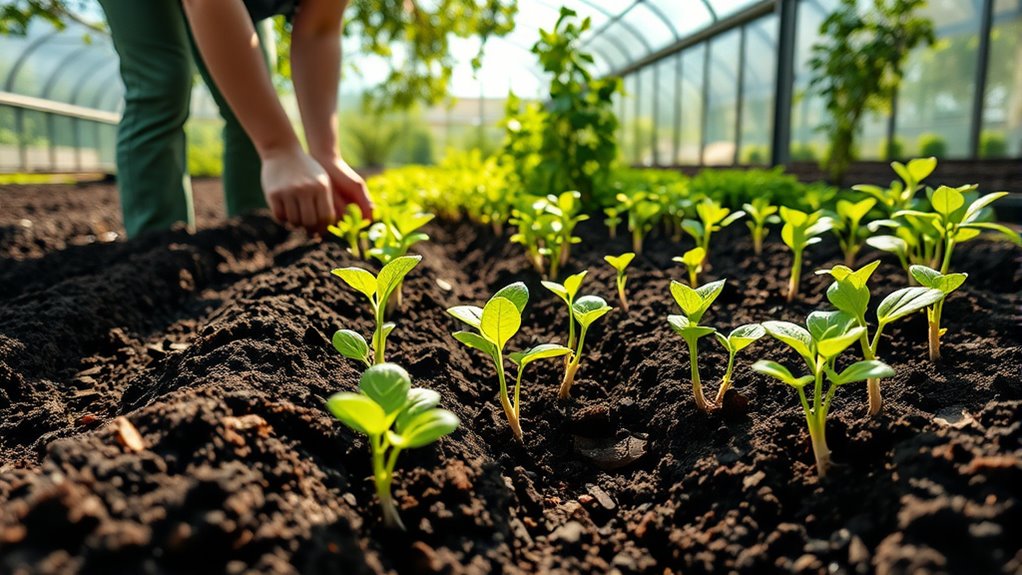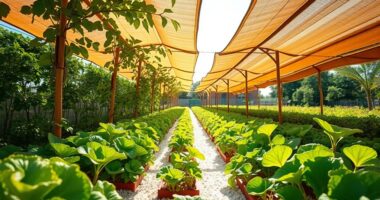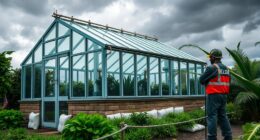To transplant seedlings from your greenhouse into your garden in spring, first prepare the soil by removing weeds, loosening it, and mixing in compost. Wait until after the frost danger, with daytime temperatures above 50°F, and handle seedlings carefully. Dig holes twice as wide as the root balls, gently place the plants, and water thoroughly. For more detailed steps and tips on caring for your new garden plants, keep exploring these essential techniques.
Key Takeaways
- Harden off seedlings gradually by exposing them to outdoor conditions over a week before transplanting.
- Ensure soil is prepared, enriched with compost, and has proper pH for healthy seedling establishment.
- Transplant after the danger of frost has passed and daytime temperatures are consistently above 50°F (10°C).
- Dig holes twice as wide as seedling root balls, gently place seedlings, and water thoroughly to reduce transplant shock.
- Monitor moisture levels and pests post-transplant, providing shade if needed and maintaining proper soil conditions.

Spring is the perfect time to move your seedlings from the greenhouse to your garden, giving them the opportunity to thrive outdoors. Before you transplant, it’s essential to prepare your soil properly. Well-drained, fertile soil provides seedlings with the nutrients and stability they need to establish strong roots. Start by removing any weeds or old plant debris from your planting area. Loosen the soil with a garden fork or tiller, mixing in compost or organic matter to enrich it. This not only improves soil fertility but also enhances aeration, helping roots breathe and grow efficiently. Keep in mind that soil pH can affect nutrient availability, so testing and adjusting pH levels if needed will give your seedlings a healthy start.
Once the soil is ready, it’s time to think about pest management. Transplanting is a vulnerable stage for seedlings since they’re susceptible to pests like aphids, slugs, and cutworms. To minimize damage, inspect your seedlings carefully before transplanting and choose the healthiest ones. When planting, avoid overcrowding to improve air circulation, which can reduce the risk of fungal diseases and pests. Applying a layer of mulch around your plants helps retain moisture, regulate soil temperature, and can also serve as a barrier against crawling pests. For organic pest management, consider using beneficial insects like ladybugs or applying neem oil or insecticidal soap if pests become a problem. Regularly check your plants for signs of pests or disease, taking prompt action to prevent infestations from spreading. Additionally, ensuring you have up-to-date hours for local garden centers can help you get the supplies you need promptly.
Timing is vital for successful transplanting. Wait until the danger of frost has passed and daytime temperatures are consistently above 50°F (10°C). When transplanting, handle seedlings gently to avoid damaging their delicate roots. Dig a hole twice as wide as the root ball, place the seedling in gently, and firm the soil around it. Water thoroughly after planting to settle the soil and eliminate air pockets. Keep an eye on weather conditions during the first few days, providing shade if necessary to reduce transplant shock. As your seedlings adjust, continue practicing pest management strategies and monitor soil moisture levels, ensuring they stay evenly moist but not waterlogged.
Frequently Asked Questions
How Do I Prevent Transplant Shock in Seedlings?
To prevent transplant shock, you should focus on root hardening and transplant timing. Gradually expose your seedlings to outdoor conditions to strengthen their roots before transplanting. Wait until the seedlings are strong and weather conditions are suitable, avoiding overly hot or cold days. Properly water them before and after transplanting, and handle roots gently. These steps help your seedlings adapt smoothly, reducing stress and encouraging healthy growth.
What Soil Amendments Improve Seedling Survival Outdoors?
You can boost seedling survival outdoors by using soil amendments like organic compost, which enriches nutrients and improves drainage. Don’t overlook soil pH adjustments; testing and balancing pH guarantees plants absorb nutrients effectively. Adding compost also fosters beneficial microbes that help seedlings establish quickly. These simple steps make your seedlings more resilient to outdoor conditions, giving them the best chance to thrive once transplanted.
When Is the Best Time to Transplant Seedlings?
You should transplant seedlings when they’re strong enough, usually after they’ve undergone seedling hardening for about a week. The best transplant timing is when the weather is consistently warm, and the risk of frost has passed. Keep an eye on soil temperature and daytime temperatures, aiming for at least 55°F (13°C). Transplant on a cloudy day or in the late afternoon to reduce transplant shock.
How Should I Water Seedlings After Transplanting?
Your seedlings need water like a desert needs rain, so keep soil moisture consistently balanced. After transplanting, water gently but thoroughly to settle the soil around roots. Water frequently enough to keep the top inch of soil moist, but avoid overwatering, which can drown roots. Check soil moisture daily, especially during warm weather, ensuring your seedlings stay happy and healthy as they grow into strong, vibrant plants.
Can I Transplant Seedlings During Cloudy or Rainy Days?
Yes, you can transplant seedlings during cloudy or rainy days. Weather considerations like overcast skies or rain help reduce transplant shock by keeping the soil moist and protecting seedlings from direct sunlight. Timing is essential—choose a day with mild weather, avoiding heavy rain or strong winds. Transplanting during these conditions allows seedlings to settle in gradually, promoting healthy growth and minimizing stress.
Conclusion
Transplanting seedlings is like guiding delicate butterflies from their cozy chrysalis into the bright, open garden. With gentle hands and mindful care, you’ll help your plants spread their wings and flourish in the spring sun. Remember, patience and attention turn tiny sprouts into vibrant blooms. Embrace this progression as a beautiful journey, watching your garden grow stronger and more colorful each day. Soon, you’ll enjoy the sweet reward of a thriving, bountiful garden blossoming under your nurturing touch.








